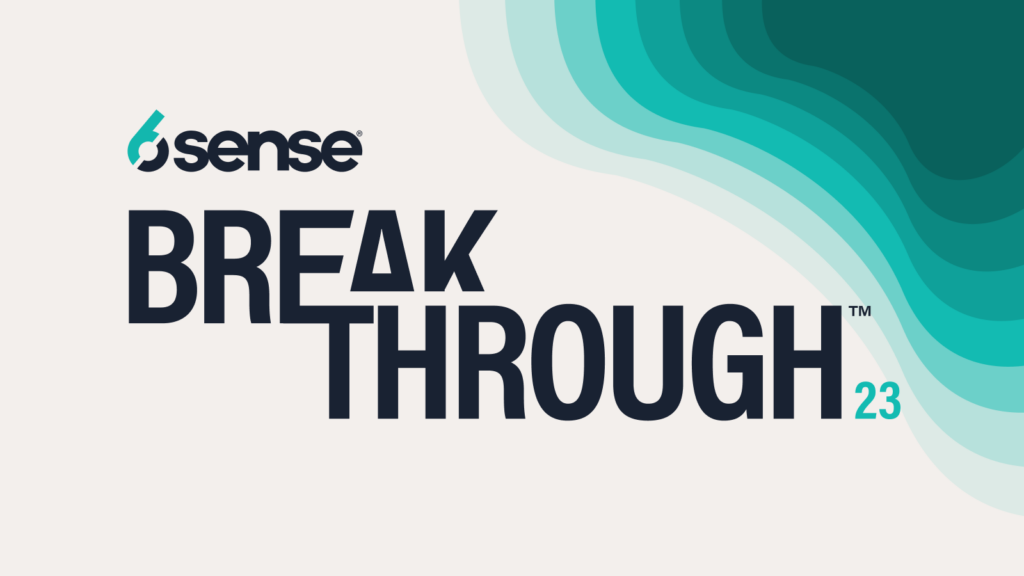6sense has paved the way for predictive models in account-based sales and marketing since we were founded in 2013, and in recent years we’ve skyrocketed to the top of the class — having been recognized as a leader in The Forrester Wave™: Predictive Marketing Analytics for B2B Marketers, Q2 2017; The Forrester Wave™, B2B Customer Analytics, Q1 2019; The Forrester New Wave™: ABM Platforms, Q2 2020; 6sense Named a Leader in The Forrester New Wave™: ABM Platforms, Q1 2022 and in seven different G2 Grid® reports, including Account-Based Advertising.
While most ABM vendors didn’t start out with a foundation in predictive models, AI and machine learning have been a core part of the 6sense Account Engagement Platform since our inception. Whereas many vendors started with basic advertising capabilities, we began at the intersection of intent signals, account identification, and predictive analytics, and then spent the last five years layering native advertising, sales intelligence, and orchestration capabilities on top of our predictive foundation.
Some ABM vendors are finally catching onto the importance of predictive models, but our head start in the predictive space continues to give our customers a competitive advantage. We have a patented approach to delivering AI-driven predictions, and our predictive models help B2B businesses understand not just who to target (down to the contact level), but also why, when, and how to engage, acquire, and retain accounts — without guesswork or cutting corners. 6sense also provides out-of-the-box reporting on how our predictive scores are driving pipeline and revenue compared to a customer’s historical data.
Here we’ll take a deeper dive into each of our five primary predictive models and why they’re essential for scaling an account-based sales and marketing strategy, and we’ll also touch on some of the other ways that AI powers the 6sense Account Engagement Platform.
Predictive Model #1: Account Fit
Good things come to those who wait… but great things come to those who uncover their true ideal customer profile (ICP). Most revenue teams have an idea as to who their target market is on paper, but that often excludes whole segments that are relevant to their business — or includes accounts that actually aren’t an ideal fit. That’s where our account fit model comes in: predicting the accounts that are truly an ICP fit based on your sales and marketing data, not a whiteboarding session between sales and marketing.
As we’ve seen with hundreds of customers, this model uncovers accounts that are an ICP fit yet had gone unseen and unengaged in the past. That’s what we refer to as “finding the whitespace” to reveal the total addressable market (TAM) of accounts you could sell to, and this is the first step in determining the audiences you want to engage. This model produces both a numeric score (i.e., 1-100) and a classification (i.e., a strong, moderate, or weak fit), both of which can be used for building audiences of accounts for analysis and campaigns or outreach. And like all of our predictive models, it continually learns, so it adapts as your product, market, and buyers change and evolve over time.
Predictive Model #2: Contact Fit
The larger the organization, the more people there are to sort through to find the buyers for your products or solutions. Another reason historical data is important to our approach to predictive modeling is because it enables us to understand who the most important contacts are within an account. For instance, at 6sense, we generally sell to sales and marketing personas; if we see that someone in IT is visiting our pages and engaging with our content, our contact fit model knows from our historical data that they’re not typically an important persona for us.
This model looks at historical data to determine the most important contacts in typical deal cycles, and then maps out the contacts in the buying center within an account, whether it be a small, mid-size, or larger business. It tells us what personas are most relevant and whether contacts that align to these personas exist in CRM or marketing automation (MAP). And because this model takes 6sense’s master company dataset into consideration when mapping the buying center, it can also identify where you have gaps in the buying center within your systems of record. For example, the model can determine if there are five people with VP-level titles within marketing at an account and flag that you only have one of these contacts in your database. With this information, your sellers can find the missing contacts via sources like LinkedIn Navigator, or 6sense can trigger an orchestration play to automatically acquire those contacts from third-party sources.
Orchestrating data enrichment and acquisition based on 6sense’s contact fit scores streamlines operations processes and ensures that your sellers have the most complete and current information on accounts and contacts at the right time — when they’re beginning the outreach process. And as we’ll talk about in the following sections, 6sense’s predictive models also ensure reps know exactly when to begin calling and emailing prospects.
Predictive Model #3: Contact Engagement
This predictive model is a measure not of whether a contact engaged with you but how engaged they are with your brand based on comparison to past opportunities. Say we see that a contact who works in marketing has been on our site and attended a webinar — that may seem like a good start, but the AI might score their level of engagement as a C or D because it’s lower than what we see when you have been successful in creating pipeline.
This model goes beyond merely reporting on a buyer’s level of engagement or arbitrarily scoring it based on static, human-defined rules; instead, it uses big data to help us understand who of our contacts we’ve gotten to engage with us at a level that would predict success. And that in turn helps sales and marketing prioritize campaigns and outreach to deepen engagement with the account’s buying center.
Visiting our site and watching a webinar is a good indicator of interest, but that interest doesn’t automatically translate to a highly engaged buyer. It doesn’t tell us that this contact is ready for (or worth) targeted outreach, or for sales to turn them into an opportunity. This model helps us more immediately understand the value (or lack thereof) of a contact’s engagement with us.
Predictive Model #4: Buying Stage
Our fourth predictive model is all about understanding where each account is on the buying journey. Are they showing no relevant buying signals, just beginning their journey, or getting close to making a purchase decision? Based on your historical data — as well as the recency, frequency, and significance or an account’s intent and engagement signals — this model produces a numeric score as well as a classification in one of five buying stages: target, awareness, consideration, decision, and purchase.
Buying stage predictions help us understand which accounts to prioritize and how to help them move through the buying journey in a meaningful way — every step (or stage) of the way. When an account is in awareness or consideration, they’re considered to be in-market, meaning that they’re showing signs that they’ll make a purchase decision in the near future. Accounts in these stages are generally conducting research on third-party websites, but they’re not necessarily visiting your site. When they move into decision or purchase, they’re considered to be a 6sense Qualified Account (6QA), meaning that they’re ready to begin evaluating vendors — and that a purchase decision is imminent. Accounts in these stages are engaging with your brand by visiting your site and interacting with your ads and other campaigns. Some (or even all) of this engagement may still be anonymous, but they’re zeroing their research in on your brand.
The decision or purchase stages are when a buyer is most likely to fill out a form with real information, but if you wait for that inbound to come to you, you’re already too late. By then, they’ve done their research and identified vendors to evaluate, and they could be talking to three of your competitors. That’s why working 6QAs is critical. Here at 6sense, our BDRs initiate outreach to accounts as soon as they reach 6QA status, and they prioritize their day using an out-of-the-box dashboard that time-stamps each account as soon as they become qualified.
Combined with our other predictive models, buying stage predictions enable sales and marketing to align on the right accounts and personas to pursue, and then deliver the right message to the right person at exactly the right time — whether via a marketing campaign or a perfectly timed sales call. Marketing begins warming ICP fit accounts and building brand awareness as soon as they become in-market, delivering stage-based campaigns aligned to the topics we know they care most about via their intent signals. At the same time, sales focuses only on accounts that our AI has predicted are ready for outreach, and they tailor their calls and emails with relevant content for members of the buying committee. And by focusing on 6QAs, 6sense customers convert accounts into opportunities more than 10x higher on average than their historical baseline.
Predictive Model #5: Account Reach
One of our newer predictive models is the account reach score, which represents a measure of the quality, quantity, recency, and diversity of outreach activities on a given account compared to that for previously won opportunities. These scores enable prospecting teams to evaluate the success of their outreach to prioritized accounts and prioritize other critical engagement activities.
Revenue teams leverage this predictive model to increase go-to-market efficiency, like deprioritizing accounts that have received a high level of outreach yet are still engaging at low levels. Similarly, teams can leverage AI to learn from previous wins and determine if anything differently should be done with an account that is engaging — but isn’t yet where we’d hoped they’d be in terms of our contact engagement and buying stage predictions.
And for marketers and operations, account reach scores are one of the dozens of options available when building dynamic account segments, which automatically update when criteria are met (or no longer met). These segments can be leveraged to trigger actions and personalization across any channel. For example, accounts with low versus high reach might get different levels of personalization on your website, be included or excluded in direct mail campaigns, or see different ads as they browse the Internet.
Accounts, Contacts, and Products All Matter
Some ABM vendors offer predictive models that focus solely on account fit and pipeline probability. But as everyone in B2B knows, contracts aren’t signed by nebulous accounts; sellers ultimately must engage people.
Understanding which accounts are a good fit for your business — and how likely they are to become opportunities — is a good start, but it’s critical to also understand which contacts are most important to engage, how engaged they are compared to previous successes, and how successful sales and marketing have been in reaching an account. Having historical context, along with five predictive models, helps us enable our customers to understand which contacts within accounts are most important to engage — or deepen engagement with.
Additionally, it’s important that predictive models be tailored to different products. If a company sells both cloud and on-premise storage, for example, the buying journey — and the buying team — can be dramatically different for those products, and a one-size-fits-all approach is unlikely to deliver accurate predictions. Predictive models must be at the individual product level in order to deliver ROI.
Clean Data and Backtesting: the Secret Sauce
6sense’s embedded CDP ingests two years of historical activity data from a customer’s MAP and CRM when they first come onboard, and then our data onboarding process cleans, normalizes, and deduplicates data. Much as it would be great to say we pull in all that historical data and begin modeling in real-time, the backend work of standardizing and cleaning data takes thought and time. And it’s a critical process, as CRM and MAP data is notoriously dirty, nor are any two companies the same in how they store and utilize data. (According to Forrester, only 12% of B2B marketers have high confidence in the accuracy of the data they manage.) The goal of this process is to make sure the data is consistent, as AI-powered models require a solid foundation of data in order to formulate accurate predictions.
Just like the hard work with data, backtesting is part of our onboarding process for every customer that purchases a subscription with predictive models. Backtesting compares the results of predictive scores to past data to validate that our AI-driven models will provide a significant uplift to your business, and this process enables our data science team to fine-tune models for your unique business, market, and products.
After the initial onboarding, customers can use self-service reports within the 6sense platform to look at their own backtests at any time. These reports detail how our predictive models are performing as compared to their historic baseline. For instance, customers can find out how accounts predicted to be a strong ICP fit are converting into opportunities and revenue compared to the baseline. These reports also provide insight into the factors weighed by the AI in making predictions. This level of transparency is essential to build trust in our models, which in turn enables our customers to generate alignment across the revenue team and scale their account-based programs.
AI: Our Foundation and Our Future
And that’s not all for AI… far from it. We’re always incorporating AI into other parts of our platform — the release of our Next Best Actions feature in 2020 being a good example. Next Best Actions provides sales reps with a prioritized list of recommended actions to engage the buying team within a target account. And there’s much more to come with AI in the 6sense platform in 2021!
Predictive models may be smart, but they don’t need to be secretive. The more data, consistency, and transparency we provide our customers, the more likely they are to see measurable, repeatable results. And ultimately, our mission is to deliver meaningful results that help our customers transform their business and break through their revenue goals.






